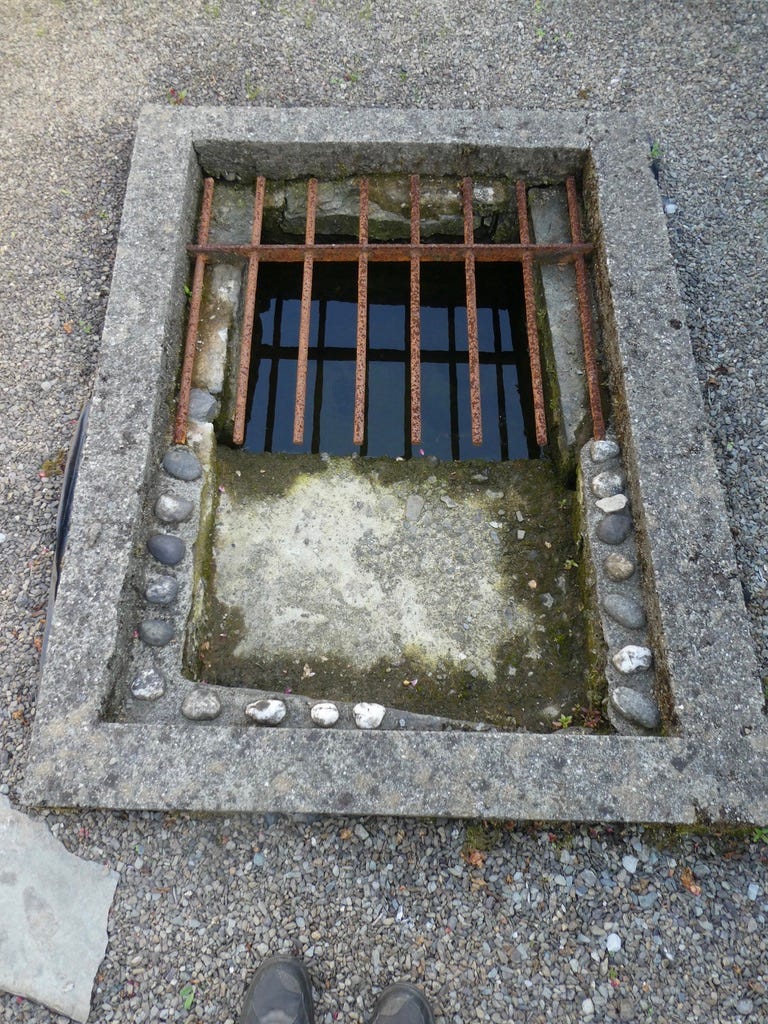St Fachtna’s Well, Burgatia, County Cork
Ye gods! What on earth has happened here?
Down a country lane in the backwaters of County Cork, we find our second well dedicated to the somewhat obscure St Fachtna. And what contrasts they are. While the first was a beautiful, bleak, vernacular limestone construction on the plains of the Burren in County Clare, this time we find … something else. Something which, with the best will in the world, feels either depressing or downright sinister. And not sinister in a good way: not in a down-the-end-of-an-ivy-hung-lane-by-a-spooky-castle-in-the-woods kind of a way. No, this well is sinister in the way that the entrance to Hades would be sinister if it had been subject to a recent health and safety audit by the local council.
Oh dear, oh dear.
We all know that the road to hell - and, indeed, Hades - is paved with good intentions, but are we quite so aware of the sheer terror that can be induced by a bureaucracy when its intentions are good? Surely there is nothing worse on this good green earth than a committee, a council, an official body or a box-ticking institution in receipt of public funds which decides to take a public monument into its care and … shudder … improve it? The only competitor, in terms of sheer destructive force, is the naked drive for profit, which can also ruin places and landscapes beyond recognition. And yet somehow this is less bad. Profiteers are just profiteers. They’re in it for the money and usually don’t pretend otherwise. We know what we’re dealing with there. But when public bodies which are supposed to defend ‘heritage’ end up ruining it, what excuse can they offer?
Yes, I’m ranting, and I apologise, but also I don’t. I am old-fashioned and eccentric and reactionary and I like old, forgotten things and I’m not apologising for any of that either. I want my holy wells to be messy and rough-edged and aboriginal. I want them to ancient and smothered in ivy and carved by hand and hung with offerings that have blended with the stone and the water and the statue of the saint. I do not want them to be straight-edged and mechanical and safe and tidied up and concreted into oblivion. I mean, it’s not as if this this is in a city centre. We drove up and down endless country lanes to get here. And this is what we find?
Alright: I need to control myself. I should get a grip. Fine. Let’s try to accentuate the positive here. After all, somebody probably worked hard on this. What’s it to them that some random visitor doesn’t approve? Look, they even put little pebbles around the side of the water:
No, it’s no good. I can’t do it. This is just not right. A holy well should not look like a municipal drain, and I don’t care who says otherwise.
When did this ‘revamp’ happen, I wonder? It wasn’t always the case that the well looked like this, according to the ever-illuminating local schoolchildren of the 1930s:
Articles of piety are hung on the bush beside the well, scapulars, rosary beads or medals. Sometimes medals or money are thrown into the well. Silver coins are rarely left there, a few coppers are thrown into the well or placed on a stone beside it. All the money left near the well is taken by tinkers, who come to Ross for the occasion. The local people never touch it, but they are all quite satisfied that the tinkers take it.
Pieces of cloth are tied on the hawthorn bush by the pilgrims, and left there. A trout is supposed to inhabit the well. It would not be right to interfere with the trout, and no one has ever meddled with it. If people see the trout when praying to obtain a cure, their request will be granted. If the trout is not visible, it is a sign that God does not will the cure of the sick person.
There is no sign of a rag tree now, and no self-respecting trout would be swimming around beneath that rusty grate. Nobody is allowed to say ‘tinkers’ anymore, at least officially, but anyone, tinker or otherwise, who turned up now in the hope of pilfering any offerings would be disappointed. There is no sign of anything being offered here. A less holy-feeling place can barely be imagined.
Still, somebody did plant a nice rosebush.
What of St Fachtna - or Fachtnan, depending on the spelling? He was a local saint, founder of an Abbey in nearby Rosscarbery, where last week’s well was to be found. Fachtna’s Abbey was renowned for its scriptorium, and was said to be the alma mater of St Brendan the Navigator. The two best stories about St Fachtna are firstly that he was nicknamed Mac Mongach, which means ‘Hairy Child.’ Slightly disappointingly, this was apparently because he was born with a full head of hair, rather than, as I had imagined, that he was entirely covered in it. The other story is that Fachnta was cured of an eye disease after bathing his eyes in the milk of the mother of another saint, Mochoemoc. I’m not sure how this transpired, but it seems that breastmilk is recognised as a good cure for eye infections even now.
What else can I say? Only that I’m glad I had visited so many other wells before coming across this one. I’m also glad I visited on a sunny day. In the rain, the resemblance to a prison yard might have been too much to bear. I hope St Fachtna isn’t too upset by all the concrete. I suppose he always has the Burren to fall back on.








A most excellent holy rant! I, too, feel better, even via proxy. Saints and tarmac...rant indeed!
Terrible tragedy but great reading, as usual. Thank you.